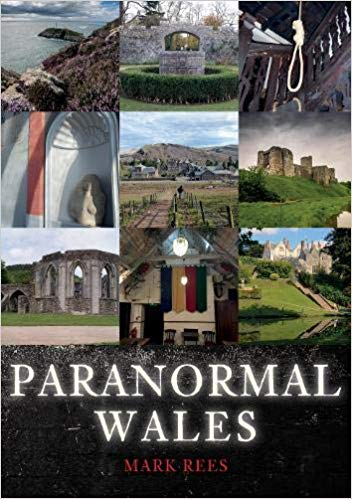
Reviewed by Tim Prasil
I was introduced to Mark Rees’s work in charting ghostly history through his book Ghosts of Wales: Accounts from the Victorian Archives (History Press, 2017). There, Rees provides summary and extensive quotation of a variety of Welsh newspaper articles from the mid- to late-1800s. His newer work, Paranormal Wales, similarly presents a compilation of ghostlore; however, the focus here is on better remembered hauntings and supernatural stories still in circulation.
In fact, Paranormal Wales could easily be used as a 21st-century guide to the country’s unearthly attractions. Its ample and colorful photographs especially make it appealing to tourists, whether they travel by car or armchair. On the other hand, Rees also captures a sense of what kinds of supernatural phenomena are alleged to roam the Welsh landscape. The spirit of a broken-hearted woman lurks amongst the grounds of Rhuddlan Castle in Denbighshire, for example, and Rees provides a full account of her sad background. The phantom of a man, the victim of an 1859 storm in the Irish Sea, still alerts the living of danger by stomping the floor, rapping the windows, and shaking the door at South Stack Lighthouse in Anglesey. Untraceable organ music, person-shaped mists, and a spectral stink of fish have been reported at the Prince of Wales pub in Bridgend.
I believe that section on the Prince of Wales pub is the only one in which Rees directly quotes a witness. His sources for most of the stories are secondhand, and his bibliography offers a nice list of books on the folklore and ghost stories of Wales, Britain, and specific regions of Britain. The publication dates reach back to the early 1800s. Though Rees frequently names these sources in the main body of the book, at least as often he uses phrases such as “it is said” instead of clear indications of when or by whom “it” was said. In this regard, readers seeking well-documented accounts of currently active supernatural phenomena—not history or hearsay—might be a bit disappointed in Paranormal Wales. One must expect a few whiffs of musty mould when pursuing ghosts, though, and these matters might be unavoidable when covering so many accounts of the otherworldly.
With this in mind, Paranormal Wales acts as a leisurely wander through Wales, a stroll in search of its spooky but charming national heritage. Rees remains journalistic both in language style and in maintaining objectivity on the reality of the hauntings. That casual non-specialists are the target audience is also reflected in the book’s brevity: it is just under 100 pages long.

